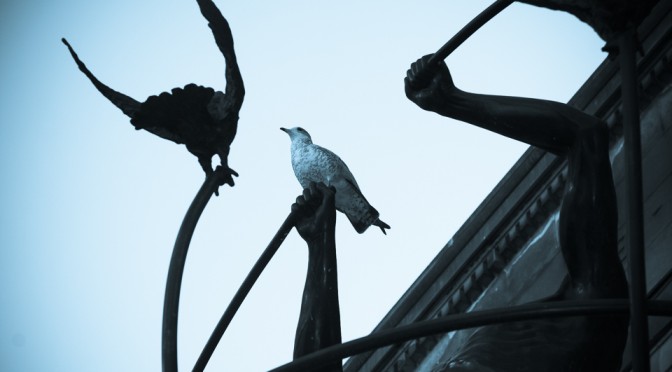On the evening of the ninth anniversary of 9/11, the twin columns of light projected as a memorial over the World Trade Center site became a source of mystery. Illuminated in the beams were thousands of small white objects, sparkling and spiralling, unlike anything seen on other nights. Some viewers wondered if they were scraps of paper or plastic caught in updrafts from the spotlights’ heat. From beneath, it was at times like gazing into a snowstorm. It was hard not to think of souls.
Those unidentified objects have now been identified as birds, pulled from their migratory path and bedazzled by the light in a perfect, poignant storm of avian disorientation. ((http://www.wired.com/wiredscience/2010/09/tribute-in-light-birds/))
I recently returned from two weeks in Vancouver, my hometown. I grew up in the suburbs but lived in different neighbourhoods around the city for nearly ten years before moving to Ottawa. It is fair to say that I knew the city and its surrounds well. I’ve been back numerous times since but finally had the chance to explore the Concord Pacific lands, Coal Harbour and the downtown East Side in more detail. Of course I’ve been following the post-Expo and pre-Olympic flurry of work online but I was still overwhelmed by the scope of that infill development in a way that was unexpected.
On several occasions I couldn’t tell where I was. I was crowded by columns of brand-spanking new shiny highrises, I couldn’t see the water and the mountains were blocked from view. I had lost all the geographical markers I counted on for my orientation. The buildings were dazzling and the area an excellent example of New Urbanism but clearly the man-made had trumped the nature-made. As I emerged at the shoreline of False Creek, even the contours of the land had been altered to dovetail with the planned aesthetic.
I experienced much the same feeling in the suburban areas around Cloverdale and Langley. Semi-detached houses and a mind-boggling volume of retail utterly fill to the brim what was recently true countryside full of working farms and equestrian centres. Without looking at the street numbers and house addresses I couldn’t identify where I was on stretches of road that I had driven hundreds if not thousands of times before. And Ottawa is not immune to this problem.
When I first moved to the city I had trouble orienting myself because of the general flatness of the terrain and the oddities caused by the lay of the canal. The pervasive construction of tract housing further erased identifying points and lines. I took a “short cut” through Barrhaven and ended up driving around and around, unable to find my way out, a difficulty compounded by the lack of a numerical grid. Each street looked identical and I began to feel strangely sweaty and panicked. I had to pull over and ask a lone pedestrian for directions.
Just before 5 a.m. on Sept. 12, the lights were turned off and on for the final time, said John Rowden, citizen science director at the Audubon Society’s New York City chapter. In the next hour, birds gathered again. “As soon as they could get any visual horizon, they could use that as a cue and navigate their way out,” he said. With dawn the birds departed.
Both Vancouver and Ottawa are relatively small cities on a worldwide scale and growing more slowly than their Asian and African counterparts. Are these feelings of disorientation amplified for residents of the fastest growing cities in the world? Or are these residents so new that they lack the nostalgia of knowing what was? With globalism are we all better off being more flexible and less attached to specific physical locations? And is geography, and its companion history, an old-fashioned notion? As I stood among the urban strangeness I felt the same uneasy mix of vague dissatisfaction, envy and peevish excitement that I get when I spend too much time inside a shopping mall.
Maybe I just need to stuff those feelings down, ditch my archaic intuition, and leverage the GPS function on my smartphone more often. How 21st century of me.
